Yuanyuan Chen
Can Textual Gradient Work in Federated Learning?
Feb 27, 2025Abstract:Recent studies highlight the promise of LLM-based prompt optimization, especially with TextGrad, which automates differentiation'' via texts and backpropagates textual feedback. This approach facilitates training in various real-world applications that do not support numerical gradient propagation or loss calculation. In this paper, we systematically explore the potential and challenges of incorporating textual gradient into Federated Learning (FL). Our contributions are fourfold. Firstly, we introduce a novel FL paradigm, Federated Textual Gradient (FedTextGrad), that allows clients to upload locally optimized prompts derived from textual gradients, while the server aggregates the received prompts. Unlike traditional FL frameworks, which are designed for numerical aggregation, FedTextGrad is specifically tailored for handling textual data, expanding the applicability of FL to a broader range of problems that lack well-defined numerical loss functions. Secondly, building on this design, we conduct extensive experiments to explore the feasibility of FedTextGrad. Our findings highlight the importance of properly tuning key factors (e.g., local steps) in FL training. Thirdly, we highlight a major challenge in FedTextGrad aggregation: retaining essential information from distributed prompt updates. Last but not least, in response to this issue, we improve the vanilla variant of FedTextGrad by providing actionable guidance to the LLM when summarizing client prompts by leveraging the Uniform Information Density principle. Through this principled study, we enable the adoption of textual gradients in FL for optimizing LLMs, identify important issues, and pinpoint future directions, thereby opening up a new research area that warrants further investigation.
Federated Graph Learning with Adaptive Importance-based Sampling
Sep 23, 2024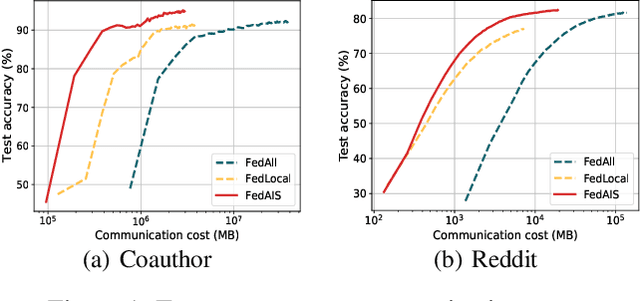
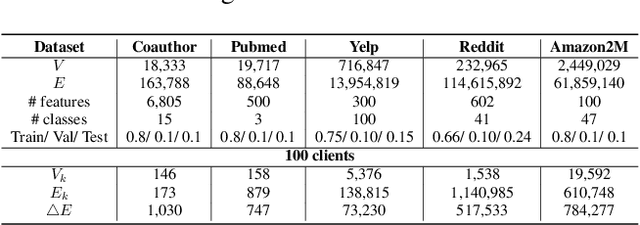
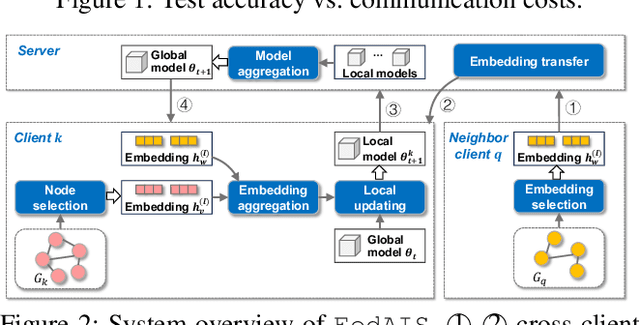
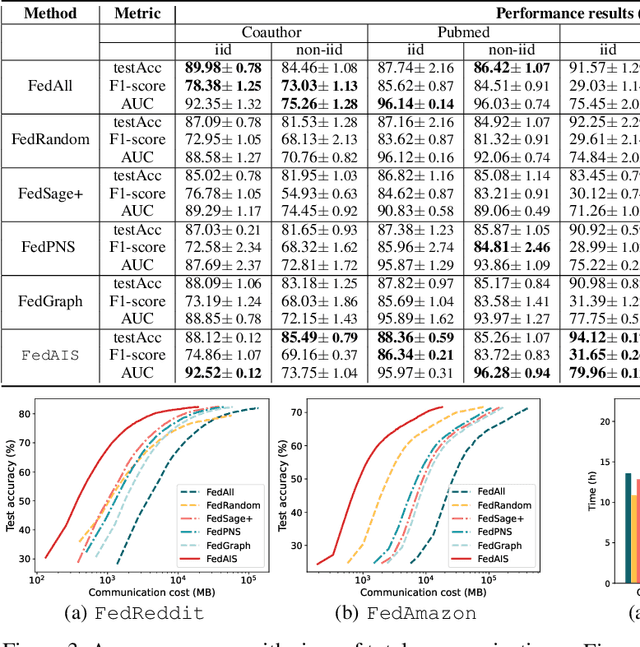
Abstract:For privacy-preserving graph learning tasks involving distributed graph datasets, federated learning (FL)-based GCN (FedGCN) training is required. A key challenge for FedGCN is scaling to large-scale graphs, which typically incurs high computation and communication costs when dealing with the explosively increasing number of neighbors. Existing graph sampling-enhanced FedGCN training approaches ignore graph structural information or dynamics of optimization, resulting in high variance and inaccurate node embeddings. To address this limitation, we propose the Federated Adaptive Importance-based Sampling (FedAIS) approach. It achieves substantial computational cost saving by focusing the limited resources on training important nodes, while reducing communication overhead via adaptive historical embedding synchronization. The proposed adaptive importance-based sampling method jointly considers the graph structural heterogeneity and the optimization dynamics to achieve optimal trade-off between efficiency and accuracy. Extensive evaluations against five state-of-the-art baselines on five real-world graph datasets show that FedAIS achieves comparable or up to 3.23% higher test accuracy, while saving communication and computation costs by 91.77% and 85.59%.
Fully Automated OCT-based Tissue Screening System
May 15, 2024Abstract:This study introduces a groundbreaking optical coherence tomography (OCT) imaging system dedicated for high-throughput screening applications using ex vivo tissue culture. Leveraging OCT's non-invasive, high-resolution capabilities, the system is equipped with a custom-designed motorized platform and tissue detection ability for automated, successive imaging across samples. Transformer-based deep learning segmentation algorithms further ensure robust, consistent, and efficient readouts meeting the standards for screening assays. Validated using retinal explant cultures from a mouse model of retinal degeneration, the system provides robust, rapid, reliable, unbiased, and comprehensive readouts of tissue response to treatments. This fully automated OCT-based system marks a significant advancement in tissue screening, promising to transform drug discovery, as well as other relevant research fields.
Active Noise Control Portable Device Design
Nov 01, 2023Abstract:While our world is filled with its own natural sounds that we can't resist enjoying, it is also chock-full of other sounds that can be irritating, this is noise. Noise not only influences the working efficiency but also the human's health. The problem of reducing noise is one of great importance and great difficulty. The problem has been addressed in many ways over the years. The current methods for noise reducing mostly rely on the materials and transmission medium, which are only effective to some extent for the high frequency noise. However, the effective reduction noise method especially for low frequency noise is very limited. Here we come up with a noise reduction system consist of a sensor to detect the noise in the environment. Then the noise will be sent to an electronic control system to process the noise, which will generate a reverse phase frequency signal to counteract the disturbance. Finally, the processed smaller noise will be broadcasted by the speaker. Through this smart noise reduction system, even the noise with low-frequency can be eliminated. The system is also integrated with sleep tracking and music player applications. It can also remember and store settings for the same environment, sense temperature, and smart control of home furniture, fire alarm, etc. This smart system can transfer data easily by Wi-Fi or Bluetooth and controlled by its APP. In this project, we will present a model of the above technology which can be used in various environments to prevent noise pollution and provide a solution to the people who have difficulties finding a peaceful and quiet environment for sleep, work or study.
Aggregating Intrinsic Information to Enhance BCI Performance through Federated Learning
Aug 14, 2023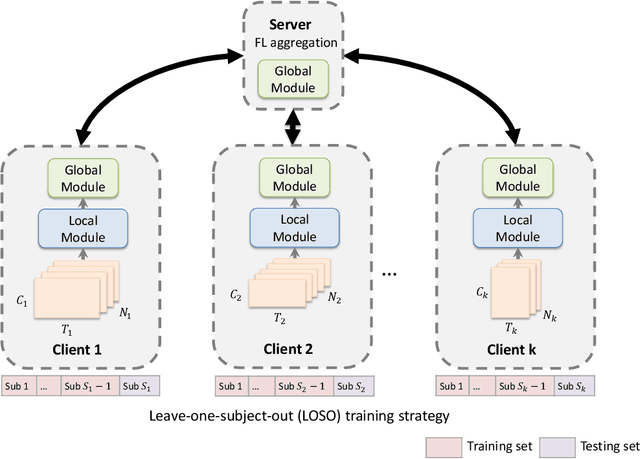


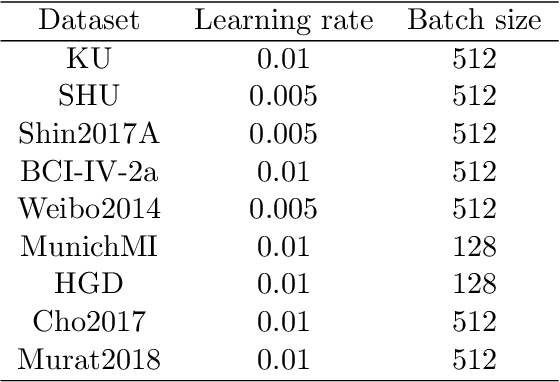
Abstract:Insufficient data is a long-standing challenge for Brain-Computer Interface (BCI) to build a high-performance deep learning model. Though numerous research groups and institutes collect a multitude of EEG datasets for the same BCI task, sharing EEG data from multiple sites is still challenging due to the heterogeneity of devices. The significance of this challenge cannot be overstated, given the critical role of data diversity in fostering model robustness. However, existing works rarely discuss this issue, predominantly centering their attention on model training within a single dataset, often in the context of inter-subject or inter-session settings. In this work, we propose a hierarchical personalized Federated Learning EEG decoding (FLEEG) framework to surmount this challenge. This innovative framework heralds a new learning paradigm for BCI, enabling datasets with disparate data formats to collaborate in the model training process. Each client is assigned a specific dataset and trains a hierarchical personalized model to manage diverse data formats and facilitate information exchange. Meanwhile, the server coordinates the training procedure to harness knowledge gleaned from all datasets, thus elevating overall performance. The framework has been evaluated in Motor Imagery (MI) classification with nine EEG datasets collected by different devices but implementing the same MI task. Results demonstrate that the proposed frame can boost classification performance up to 16.7% by enabling knowledge sharing between multiple datasets, especially for smaller datasets. Visualization results also indicate that the proposed framework can empower the local models to put a stable focus on task-related areas, yielding better performance. To the best of our knowledge, this is the first end-to-end solution to address this important challenge.
Efficient Training of Large-scale Industrial Fault Diagnostic Models through Federated Opportunistic Block Dropout
Feb 22, 2023Abstract:Artificial intelligence (AI)-empowered industrial fault diagnostics is important in ensuring the safe operation of industrial applications. Since complex industrial systems often involve multiple industrial plants (possibly belonging to different companies or subsidiaries) with sensitive data collected and stored in a distributed manner, collaborative fault diagnostic model training often needs to leverage federated learning (FL). As the scale of the industrial fault diagnostic models are often large and communication channels in such systems are often not exclusively used for FL model training, existing deployed FL model training frameworks cannot train such models efficiently across multiple institutions. In this paper, we report our experience developing and deploying the Federated Opportunistic Block Dropout (FEDOBD) approach for industrial fault diagnostic model training. By decomposing large-scale models into semantic blocks and enabling FL participants to opportunistically upload selected important blocks in a quantized manner, it significantly reduces the communication overhead while maintaining model performance. Since its deployment in ENN Group in February 2022, FEDOBD has served two coal chemical plants across two cities in China to build industrial fault prediction models. It helped the company reduce the training communication overhead by over 70% compared to its previous AI Engine, while maintaining model performance at over 85% test F1 score. To our knowledge, it is the first successfully deployed dropout-based FL approach.
FedOBD: Opportunistic Block Dropout for Efficiently Training Large-scale Neural Networks through Federated Learning
Aug 10, 2022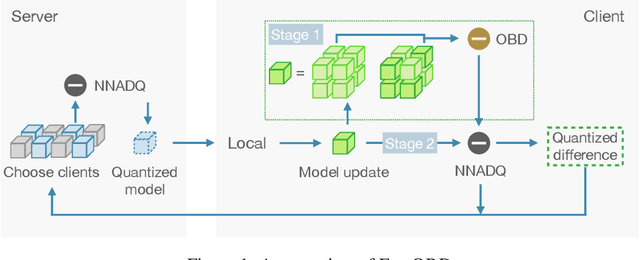
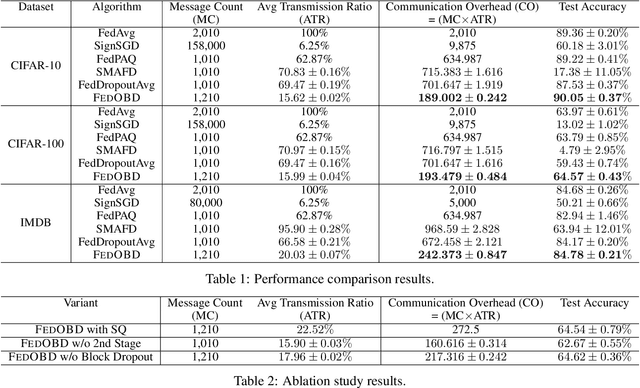
Abstract:Large-scale neural networks possess considerable expressive power. They are well-suited for complex learning tasks in industrial applications. However, large-scale models pose significant challenges for training under the current Federated Learning (FL) paradigm. Existing approaches for efficient FL training often leverage model parameter dropout. However, manipulating individual model parameters is not only inefficient in meaningfully reducing the communication overhead when training large-scale FL models, but may also be detrimental to the scaling efforts and model performance as shown by recent research. To address these issues, we propose the Federated Opportunistic Block Dropout (FedOBD) approach. The key novelty is that it decomposes large-scale models into semantic blocks so that FL participants can opportunistically upload quantized blocks, which are deemed to be significant towards training the model, to the FL server for aggregation. Extensive experiments evaluating FedOBD against five state-of-the-art approaches based on multiple real-world datasets show that it reduces the overall communication overhead by more than 70% compared to the best performing baseline approach, while achieving the highest test accuracy. To the best of our knowledge, FedOBD is the first approach to perform dropout on FL models at the block level rather than at the individual parameter level.
GTG-Shapley: Efficient and Accurate Participant Contribution Evaluation in Federated Learning
Sep 05, 2021



Abstract:Federated Learning (FL) bridges the gap between collaborative machine learning and preserving data privacy. To sustain the long-term operation of an FL ecosystem, it is important to attract high quality data owners with appropriate incentive schemes. As an important building block of such incentive schemes, it is essential to fairly evaluate participants' contribution to the performance of the final FL model without exposing their private data. Shapley Value (SV)-based techniques have been widely adopted to provide fair evaluation of FL participant contributions. However, existing approaches incur significant computation costs, making them difficult to apply in practice. In this paper, we propose the Guided Truncation Gradient Shapley (GTG-Shapley) approach to address this challenge. It reconstructs FL models from gradient updates for SV calculation instead of repeatedly training with different combinations of FL participants. In addition, we design a guided Monte Carlo sampling approach combined with within-round and between-round truncation to further reduce the number of model reconstructions and evaluations required, through extensive experiments under diverse realistic data distribution settings. The results demonstrate that GTG-Shapley can closely approximate actual Shapley values, while significantly increasing computational efficiency compared to the state of the art, especially under non-i.i.d. settings.
FocusNetv2: Imbalanced Large and Small Organ Segmentation with Adversarial Shape Constraint for Head and Neck CT Images
Apr 05, 2021



Abstract:Radiotherapy is a treatment where radiation is used to eliminate cancer cells. The delineation of organs-at-risk (OARs) is a vital step in radiotherapy treatment planning to avoid damage to healthy organs. For nasopharyngeal cancer, more than 20 OARs are needed to be precisely segmented in advance. The challenge of this task lies in complex anatomical structure, low-contrast organ contours, and the extremely imbalanced size between large and small organs. Common segmentation methods that treat them equally would generally lead to inaccurate small-organ labeling. We propose a novel two-stage deep neural network, FocusNetv2, to solve this challenging problem by automatically locating, ROI-pooling, and segmenting small organs with specifically designed small-organ localization and segmentation sub-networks while maintaining the accuracy of large organ segmentation. In addition to our original FocusNet, we employ a novel adversarial shape constraint on small organs to ensure the consistency between estimated small-organ shapes and organ shape prior knowledge. Our proposed framework is extensively tested on both self-collected dataset of 1,164 CT scans and the MICCAI Head and Neck Auto Segmentation Challenge 2015 dataset, which shows superior performance compared with state-of-the-art head and neck OAR segmentation methods.
HYDRA: Hypergradient Data Relevance Analysis for Interpreting Deep Neural Networks
Mar 01, 2021



Abstract:The behaviors of deep neural networks (DNNs) are notoriously resistant to human interpretations. In this paper, we propose Hypergradient Data Relevance Analysis, or HYDRA, which interprets the predictions made by DNNs as effects of their training data. Existing approaches generally estimate data contributions around the final model parameters and ignore how the training data shape the optimization trajectory. By unrolling the hypergradient of test loss w.r.t. the weights of training data, HYDRA assesses the contribution of training data toward test data points throughout the training trajectory. In order to accelerate computation, we remove the Hessian from the calculation and prove that, under moderate conditions, the approximation error is bounded. Corroborating this theoretical claim, empirical results indicate the error is indeed small. In addition, we quantitatively demonstrate that HYDRA outperforms influence functions in accurately estimating data contribution and detecting noisy data labels. The source code is available at https://github.com/cyyever/aaai_hydra_8686.
 Add to Chrome
Add to Chrome Add to Firefox
Add to Firefox Add to Edge
Add to Edge